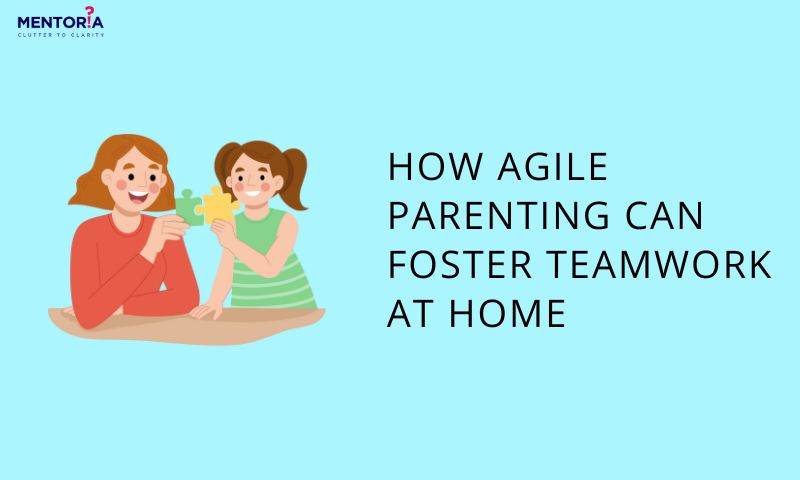How Agile Parenting Can Foster Teamwork At Home

If you’ve ever felt like parenting is a non-stop rollercoaster ride, with no user manual in sight, you’re not alone. We’ve all been there, with dirty dishes piling up, bedtime battles, and the perpetual search for lost shoes. But what if we told you there’s a way to bring structure and sanity back into your home? What if you could run your family like a high-performing, agile team?
Agile Parenting is not about strict rules or turning your family into a boot camp. It’s about embracing the principles of agility, borrowed from the world of project management and software development, and applying them to your parenting journey. It’s about flexibility, adaptability, and collaboration. It’s about teaching your children life skills and problem-solving while fostering a sense of responsibility and teamwork. So let’s help you find your rhythm and adapt to the inevitable surprises life throws your way.
Understanding Agile Parenting
Let’s start with the basics. Agile Parenting takes inspiration from the world of Agile methodology in software development. The key principles of Agile Parenting are communication, collaboration, and adaptability. It’s all about fostering a dynamic and responsive family environment.
- The Agile Mindset: Agile methodology emphasises individuals and interactions over processes and tools. In parenting, this means prioritising your child’s unique needs and building strong relationships with them.
- Iterative Planning: In Agile, plans are often adapted and refined as the project progresses. For parents, this means being open to adjusting your parenting strategies as your child grows and develops.
- Continuous Feedback: Agile encourages regular feedback to make improvements. In your household, this can translate to open and honest communication with your children, ensuring their voices are heard.
- Collaborative Approach: Agile teams work together, and so should your family. Encourage your children to be active participants in decision-making and problem-solving.
Creating An Agile Household
Now that you have a grasp of the Agile mindset, let’s explore how to put it into practice at home.
- Family Meetings: Agile Stand-Ups for the Family: One of the key elements of Agile methodology is the daily stand-up meeting. In your family, you can have regular family meetings, just like Agile stand-ups. Gather your family members, stand in a circle (or sit if you prefer), and discuss what’s on everyone’s mind. Share your daily schedules, challenges, and successes. This open forum promotes communication and teamwork within the family.
- Kanban Boards for Chores: Kanban boards are a staple in Agile project management. You can adapt this concept for your household chores. Create a Kanban board with tasks for each family member. Use sticky notes or digital tools to move tasks across columns like ‘To-Do,’ ‘In Progress,’ and ‘Done.’ It’s a visual way to track responsibilities and celebrate achievements together.
- Backlog and Prioritisation: In Agile, a backlog is a list of tasks to be completed. You can create a family backlog for activities like outings, vacations, or home improvement projects. Involve your children in prioritising the backlog items based on their preferences. This encourages them to take ownership of family decisions and feel more invested in the process.
- Agile Retrospectives for Parent-Child Relationships: Retrospectives are a critical part of Agile, where teams reflect on what went well and what can be improved. Apply this to your relationship with your children. Periodically, sit down with them to discuss what’s working and what can be better in your interactions. This not only teaches them to communicate openly but also helps strengthen the parent-child bond.
- Timeboxing: Scheduled Family Quality Time: In Agile, timeboxing is a technique that sets a fixed time for specific tasks. Implement this in your family life by creating dedicated time slots for family activities. Whether it’s a weekly game night or a monthly family outing, timeboxing ensures that family time remains a priority.
Agile Parenting Benefits
Now, you might be wondering, what’s in it for you and your family? Agile Parenting offers a range of benefits that can positively impact your household dynamics.
- Enhanced Communication Skills: Agile methodologies encourage open and transparent communication. By applying these principles to parenting, you teach your children the value of effective communication. This will help them express their thoughts and emotions more clearly, leading to healthier relationships.
- Empowerment and Responsibility: Incorporating Agile practices into your family life empowers your children by involving them in decision-making and problem-solving. They learn to take responsibility for their tasks and actions, which are essential life skills.
- Adaptable and Resilient Children: The ability to adapt to change is a crucial aspect of Agile. Teaching your children to be adaptable and resilient is a valuable gift. Agile Parenting helps them develop these qualities by encouraging them to embrace change as a natural part of life.
- Strengthened Parent-Child Bonds: Regular retrospectives and open conversations help in strengthening the parent-child relationship. By addressing concerns and celebrating achievements together, you create a supportive and loving family environment.
Challenges And Tips For Agile Parenting
While Agile Parenting has many advantages, it’s essential to be aware of potential challenges and how to navigate them.
- Resistance to Change: Children, especially older ones, may resist the shift in family dynamics at first. To overcome this, involve them in discussions about Agile Parenting, highlighting how it can benefit everyone.
- Balancing Flexibility and Structure: Agile Parenting promotes flexibility, but it’s important to strike a balance with some structure. Ensure that essential routines are maintained while allowing flexibility in other areas.
- Setting Realistic Expectations: While Agile Parenting is effective, it’s not a magical solution to all family issues. Be realistic about what it can achieve and the time it might take to see significant changes.
- Consistency is Key: For Agile Parenting to work, consistency is vital. Make sure that family meetings and Agile practices become a regular part of your family life.
Mentoria: Your Partner In Agile Parenting Success
As we wrap up our journey into the world of Agile Parenting, it’s clear that transforming our households into collaborative teams is not just a trend; it’s a fundamental shift in the way we approach parenthood. By adopting agile principles like flexibility, open communication, and a focus on continuous improvement, we can create a home environment where everyone thrives. Parents, children, and even the family pet can benefit from the Agile Parenting approach.
But what if you feel like you need some extra guidance on this parenting adventure? That’s where Mentoria comes in. Mentoria is your trusted companion on the path to becoming an agile parent through our corporate workshops for working parents. Our team of experienced counsellors can provide you with expert advice, resources, and support to make your journey smoother and more effective.









